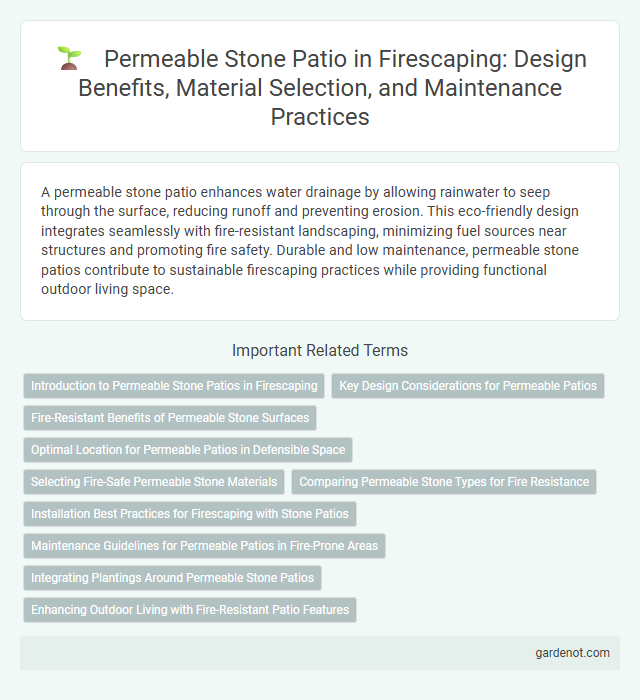A permeable stone patio enhances water drainage by allowing rainwater to seep through the surface, reducing runoff and preventing erosion. This eco-friendly design integrates seamlessly with fire-resistant landscaping, minimizing fuel sources near structures and promoting fire safety. Durable and low maintenance, permeable stone patios contribute to sustainable firescaping practices while providing functional outdoor living space.
Introduction to Permeable Stone Patios in Firescaping
Permeable stone patios play a vital role in firescaping by reducing surface runoff and promoting water absorption, which helps maintain soil moisture and minimize fire risks. These patios use porous materials like gravel, flagstone, or permeable pavers that allow water to seep through, preventing dry, flammable surfaces around structures. Incorporating permeable stone patios supports fire-resistant landscaping strategies by enhancing natural fire breaks and reducing heat build-up near homes.
Key Design Considerations for Permeable Patios
Permeable stone patios require careful attention to selecting materials with adequate permeability rates to ensure effective stormwater drainage and reduce fire hazard risks. Incorporating properly graded aggregates beneath the stone surface enhances water infiltration and supports stable footing while minimizing combustible debris accumulation. Strategic spacing of stones and integration of fire-resistant landscaping further improve safety and functionality in firescaping designs.
Fire-Resistant Benefits of Permeable Stone Surfaces
Permeable stone patios offer superior fire-resistant benefits by allowing water to infiltrate through the surface, reducing heat buildup and the risk of ignition. The stone material itself is non-combustible, creating a safe barrier against wildfire embers and radiant heat. This combination of permeability and fire resistance makes permeable stone patios an effective choice for fire-safe landscaping in high-risk areas.
Optimal Location for Permeable Patios in Defensible Space
Permeable stone patios are best located within the home's defensible space to reduce wildfire risk by allowing water to permeate and minimize flammable debris accumulation. Positioning these patios near entryways or fire-resistant landscaping enhances safety by creating buffer zones that slow fire spread and provide safe evacuation paths. Selecting areas with good drainage and minimal vegetation ensures the permeable surface maintains its fire-resilient properties while supporting effective stormwater management.
Selecting Fire-Safe Permeable Stone Materials
Selecting fire-safe permeable stone materials for a firescaping patio involves choosing stones with high thermal resistance and low flammability, such as granite, slate, and flagstone. These materials absorb and dissipate heat effectively, reducing the risk of fire spread around outdoor living spaces. Incorporating permeable stones also enhances drainage and minimizes combustible debris accumulation, contributing to overall fire safety.
Comparing Permeable Stone Types for Fire Resistance
Permeable stone patios featuring materials like flagstone, travertine, and sintered stone offer varying levels of fire resistance critical in firescaping. Flagstone typically exhibits strong fire resistance due to its dense, non-combustible composition, making it a preferred choice for high-risk fire zones. Sintered stone combines durability with exceptional heat resistance, while travertine provides moderate fire resistance but excels in permeability, crucial for managing runoff and reducing ember accumulation near structures.
Installation Best Practices for Firescaping with Stone Patios
Selecting permeable stone materials such as flagstone or crushed granite enhances water drainage and reduces fire hazards in firescaping applications. Ensuring a layered installation with a compacted base of gravel followed by sand or decomposed granite achieves stability while maintaining permeability essential for fire resistance. Proper spacing between stones promotes airflow, preventing heat buildup and reducing the risk of ignition near patio edges and adjoining vegetation.
Maintenance Guidelines for Permeable Patios in Fire-Prone Areas
Permeable stone patios in fire-prone areas require regular debris removal and clearing of flammable materials such as dry leaves and pine needles to reduce fire risk. Routine inspection of joint materials like gravel or sand helps maintain permeability and prevents weed growth that can fuel fires. Proper upkeep includes maintaining a clean, well-drained surface to ensure fire resilience and optimize water infiltration.
Integrating Plantings Around Permeable Stone Patios
Integrating plantings around permeable stone patios enhances fire-resistant landscaping by creating natural barriers that reduce heat transfer. Select fire-resistant, drought-tolerant plants such as succulents, lavender, or native grasses to complement the porous surface, which allows water infiltration and minimizes runoff. Strategic placement of low-flammable vegetation around the patio supports soil stability and increases overall fire resilience in the outdoor living space.
Enhancing Outdoor Living with Fire-Resistant Patio Features
A permeable stone patio enhances outdoor living by combining fire-resistant materials with effective drainage, reducing the risk of fire damage and water buildup. Utilizing natural stone such as flagstone or pavers that comply with fire safety standards provides a safe, durable surface ideal for fire-prone areas. Integrating gravel or permeable joints further improves safety by minimizing combustible debris accumulation while maintaining aesthetic and functional appeal.
Permeable Stone Patio Infographic

 gardenot.com
gardenot.com